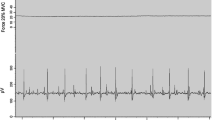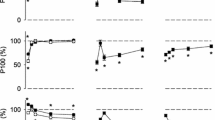Summary
Effects of 3 months training, on electrical and mechanical failures during fatigue, were studied in human adductor pollicis muscle. Eight subjects carried out a daily training program of 10 series of 20 fast (0.5 s) voluntary contractions, against a load equivalent to 30–40% of the muscle maximal force. Contractile properties in control and trained muscles are tested by delivering supramaximal electrical pulses (30 Hz) to the motor nerve, thereby triggering series of 60 1-s contractions separated by 1-s intervals. Training produces significant increase in tension development during a 30 Hz isometric tetanus (+13%;P<0.001). Concimitant rates of tension development and of relaxation are respectively augmented by +18% (P<0.001) and +12% (P<0.001). No significant change of surface muscle action potential (SAP) is observed after training. The considerable loss of force recorded during fatigue in control muscles (−36%) is significantly smaller (P<0.001) after training (−17%). Slowing of tension development and of tension relaxation, observed during fatigue in control muscles (respectively −47% and −79%) is smaller after training (respectively −28% and −65%). Analysis of electrical failure indicates that training significantly (P<0.01) reduces augmentation of muscle SAP duration and area recorded during fatigue. Comparison of time courses of mechanical and electrical failures in control and trained muscles, supports the idea that intracellular processes play the major role in tension decay associated with fatigue in human adductor pollicis muscle.
Similar content being viewed by others
References
Asmussen E (1979) Muscle fatigue. Med Sci Sports 11: 313–321
Bigland-Ritchie B, Johansson R, Lippold OCJ, Smith H, Woods JJ (1983) Changes in motoneurone firing rates during sustained maximal voluntary contractions. J Physiol 340: 335–346
Bigland-Ritchie BR, Jones DA, Hosking GP, Edwards RHT (1978) Central and peripheral fatigue in sustained maximum voluntary contractions of human quadriceps muscle. Clin Sci 54: 609–614
Bigland-Ritchie BR, Jones DA, Woods JJ (1979) Excitation frequency and muscle fatigue: Electrical responses during human voluntary and stimulated contractions. Exp Neurol 64: 414–427
Crockett JL, Edgerton VR, Max SR, Barnard RJ (1976) The neuromuscular junction in response to endurance training. Exp Neurol 51: 207–215
Duchateau J, Hainaut K (1984) Isometric or dynamic training: differential effects on mechanical properties of a human muscle. J Appl Physiol: Respir Environ Exerc Physiol 56: 296–301
Fitts RH, Holloszy JO (1977) Contractile properties of rat soleus muscle: effects of training and fatigue. Am J Physiol 233: C86-C91
Hakkinen K, Komi PV (1983) Electromyographic changes during strength training and detraining. Med Sci Sports 15: 455–460
Hermansen L (1981) Effect of metabolic changes on force generation in skeletal muscle during maximal exercise. In: Human muscle fatigue: physiological mechanisms [Ciba Foundation Symposium] Pitman Medical, London, pp 75–88
IkaÏ M, Yabe K, Ishii K (1967) Muskelkraft und muskulÄre Ermüdung bei willkürlicher Anspannung und elektrischer Reizung des Muskels. Sportarzt Sportmedizin 5: 197–211
Jones DA, Bigland-Ritchie B, Edwards RHT (1979) Excitation frequency and muscle fatigue: Mechanical responses during voluntary and stimulated contractions. Exp Neurol 64: 401–413
Magleby KL (1973) The effect of repetitive stimulation on facilitation of transmitter release at the frog neuromuscular junction. J Physiol 234: 327–352
McDonagh MJN, Hayward CM, Davies CTM (1983) Isometric training in human elbow flexor muscles. J Bone Joint Surg 65: 355–358
Merton PA (1954) Voluntary strength and fatigue. J Physiol 123: 553–564
Naess K, Storm-Mathisen A (1955) Fatigue of sustained tetanic contractions. Acta Physiol Scand 34: 351–366
Petrofsky JS, Lind AR (1979) Isometric endurance in fast and slow muscles in the cat. Am J Physiol 236: C185-C191
Sahlin K, Edstrom L, Sjoholm H, Hultman E (1981) Effects of lactic acid accumulation and ATP decrease on muscle tension and relaxation. Am J Physiol 240: C121-C126
Stephens JA, Taylor A (1972) Fatigue of maintained voluntary muscle contraction in man. J Physiol 220: 1–18
Wilkie D (1981) Shortage of chemical fuel as a cause of fatigue: studies by nuclear magnetic resonance and bicycle ergometry. In: Human muscle fatigue: physiological mechanisms [Ciba Foundation Symposium], Pitman Medical, London, pp 102–119
Author information
Authors and Affiliations
Additional information
This work was supported by the Fonds National de la Recherche Scientifique of Belgium and the Conseil de la Recherche of the University of Brussels
Rights and permissions
About this article
Cite this article
Duchateau, J., Hainaut, K. Training effects on muscle fatigue in man. Europ. J. Appl. Physiol. 53, 248–252 (1984). https://doi.org/10.1007/BF00776598
Accepted:
Issue Date:
DOI: https://doi.org/10.1007/BF00776598




